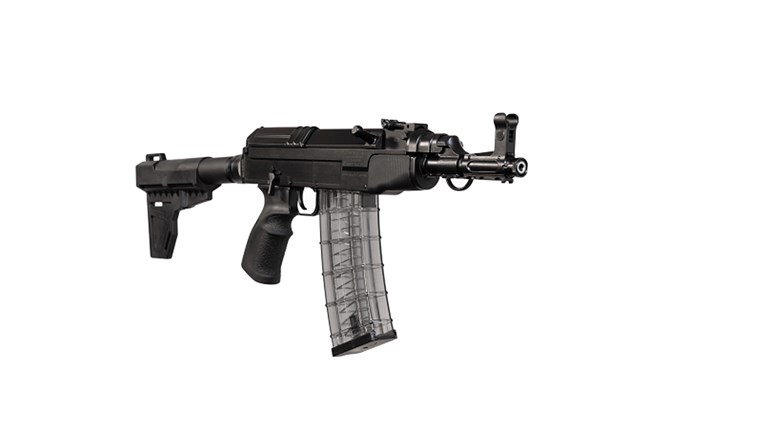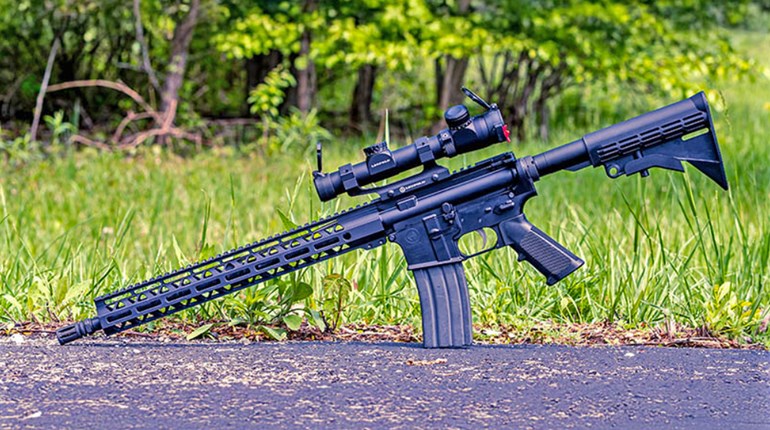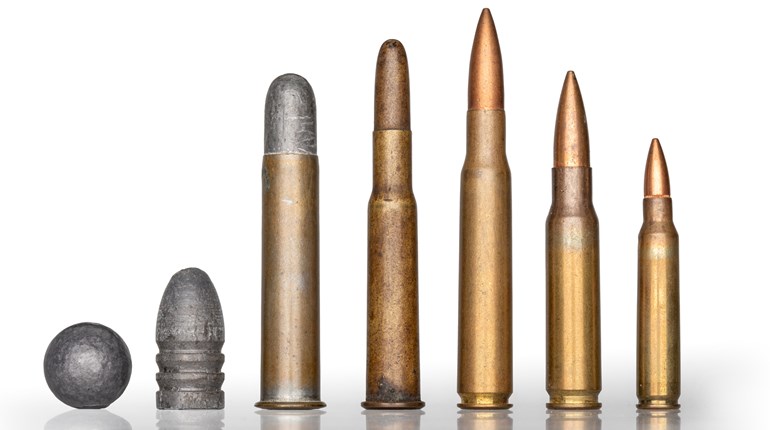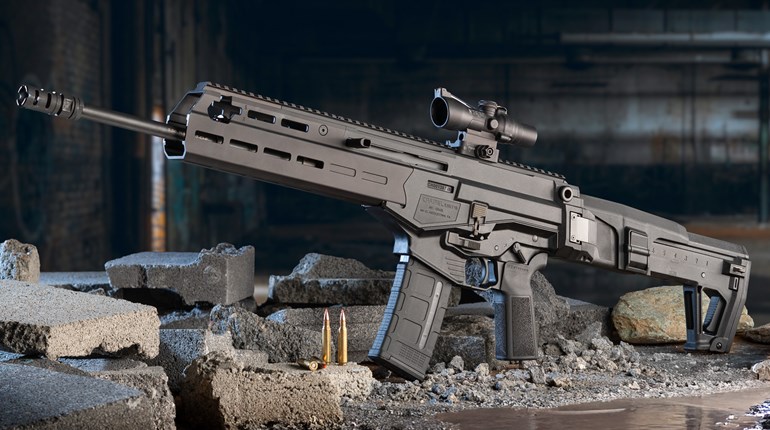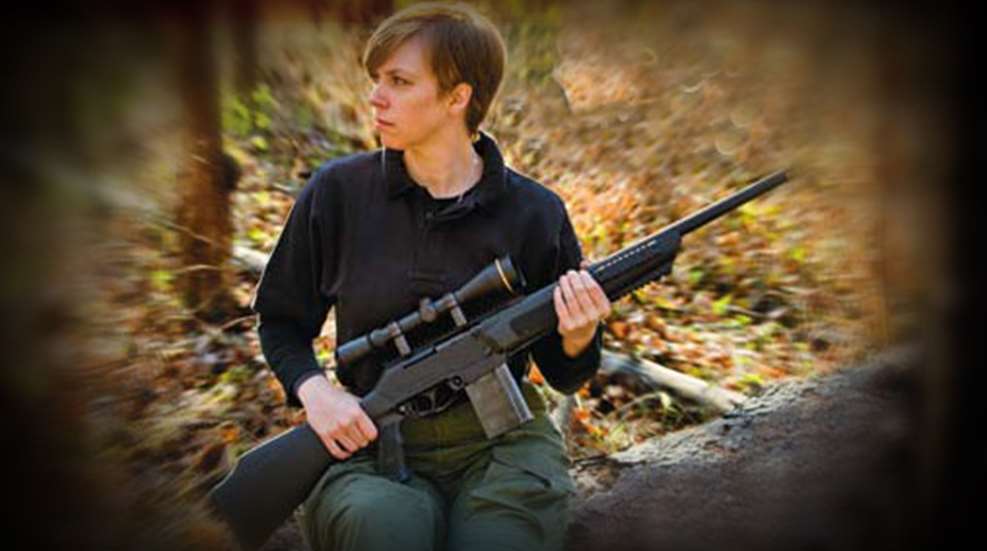
When it comes down to it, no one could seriously argue the AR-pattern rifle looks outdated. With its extensive use of alloys and synthetics as well as its legendary adaptability through its modular design, the AR easily looks the part of tomorrow's rifle. However, appearances can be deceiving. In fact, the AR's roots reach all the way back to the middle of the 20th century, with the design having the distinction of being the longest-serving primary-issue military rifle in our country's history.
What is the source of the AR's longevity? The design's appealing combination of adaptability and modularity. And the very qualities that make it so successful as a military design have also made it extremely popular among civilian shooters in its semi-automatic form.
Even the AR-based rifle's adaptability has its limits, however, and some highly specialized users in the U.S. military are now fielding the next generation of firearm. Those users are the SOF (Special Operations Forces) of USSOCOM (U.S. Special Operations Command), and the firearm is the SCAR (SOF Combat Assault Rifle) from FN Herstal.
Taking the adaptability pioneered by the AR-pattern rifle to the next level, the new FN SCAR combines today's cutting-edge technology with an even greater degree of modularity than its predecessors. In fact, the SCAR could easily represent the future of small arms development. Fortunately for civilian consumers, a semi-automatic variant of the SCAR is now available as the SCAR 16S from FNH USA.
The Usual Suspects
So why was the SCAR developed? By the nature of their roles and duties, USSOCOM forces have in the past employed a broad variety of highly specialized weapon systems. This created logistical issues for USSOCOM in regard to maintenance, repair and cost. In addition, many of these guns were simply modifications of pre-existing systems, meaning they were not necessarily fully suited to all tasks.
As a result, in 2003 USSOCOM initiated a Joint Operational Requirements Document (JORD) that began the search for a completely new SOF Combat Assault Rifle. Also, to ensure it was designed with the needs of its intended users in mind, input from members of the SOF community was solicited during the initiation and generation phase of the selection process, as well as during testing of the SCAR.
Modularity was key in the JORD's requirements. Specifically, the new rifle had to be capable of being chambered in either 5.56x45 mm or 7.62x51 mm and easily modifiable to configurations ranging from compact entry guns to carbines to long-range precision rifles. In addition, reliability and accuracy were of utmost importance.
Despite the daunting requirements, a host of renowned manufacturers offered submissions to the JORD trials, which had the distinction of being the first procurement by the United States military through full and open competition since the M16 trials in the 1960s. And, at the end of the exhaustive testing, FN Herstal's offering emerged as the winner.
"FN won the full and open SCAR competition because we showed up with a weapon that met, and more often exceeded, USSOCOM's requirements. And this was not just an existing weapon that we tweaked to compete; the FN SCAR was built from the ground up, combining some of the best features from numerous weapon designs all aimed at the primary requirements of modularity, reliability, accuracy and durability," stated Gabe Bailey, FNH USA's marketing director for Combat Rifles and Technical Support.
Looking Forward (and Back)
Building on FN Herstal's extensive knowledge regarding the development and manufacturing of high-quality, modern military firearms, the SCAR that emerged from the JORD trials was a model of modernity and modularity.
A rotating bolt, gas-piston-operated rifle, the SCAR is made up of two primary variants, specifically the SCAR-L (for light) in 5.56x45 mm and the SCAR-H (for heavy) in 7.62x51 mm. It is important to note the SCAR features 98-percent parts commonality within each of the SCAR-L 5.56x45 mm and SCAR-H 7.62x51 mm variants, and 82 percent between the two different platforms.
To allow the SCAR to be easily configured as either an entry gun, carbine or precision rifle, it was designed to employ a free-floated, quick-change barrel assembly that a trained operator can switch in 2 to 3 minutes with a pre-set torque wrench. The retention system is made up of six captive T-25 screws, with two sets of two screws located in caps on both sides of the receiver forward of the ejection port and two screws located in front of the fore-end.
Although the quick-change barrel system is a significantly modern change over the AR's design, the SCAR's system of operation is practically retro. Rather than the AR-pattern rifle's somewhat controversial direct gas-impingement system of operation, the SCAR instead employs a short-stroke gas-tappet piston system, which should run both cleaner and cooler.
Second Cousins
Driven by its commitment to the U.S. civilian market and in recognition of the fact that the obvious strengths of the SCAR would make it a wonderful platform for a semi-automatic rifle, FN set about developing a variant for the civilian market.
Although the SCAR program was focused around both a 5.56x45 mm and a 7.62x51 mm, the first offering in the SCAR line to the civilian market is the 5.56x45 mm SCAR 16S (although the company plans to unveil a 7.62x51 mm SCAR 17S semi-auto rifle at the 2010 SHOT Show).
While the SCAR 16S is visually similar to its military sibling, there are some important distinctions between the two. First and foremost, the SCAR 16S is designed from the ground up as a semi-automatic-only rifle, incapable of accepting full-automatic parts. Although this is a significant mechanical change, the only easily visible difference between the two rifles in this regard is the SCAR's lack of a third, full-automatic stop on the safety selector.
The other major difference between the two rifles is a bit easier to spot at a glance. While the military SCAR-L takes full advantage of the interchangeable barrel system with a selection of 10-, 14- and 18-inch assemblies available, the civilian SCAR 16S comes with a single 16-inch barrel assembly installed. Also differing from the SCAR-L is the SCAR 16S's muzzle device, which is a FSC556 Tactical Compensator manufactured by Primary Weapon Systems. It features open prongs on its end and curved ports on its sides.
Sum of its Parts
The SCAR 16S is made up of five major components: upper receiver assembly, moving parts assembly (bolt and bolt carrier), buttstock module, trigger module (lower receiver) and the AR-15/M16-pattern magazine.
The upper receiver assembly also includes the removable barrel assembly. The SCAR's stressed-steel bolt locks directly into a stressed-steel barrel extension, allowing the receiver to be made from extruded aluminum.
The upper receiver assembly is anodized in a flat, dark-earth color, and the upper receiver includes an integral fore-end system that extends fully forward to the gas block section of the rifle. This provides an uninterrupted strip of Picatinny rail along the SCAR's entire top, offering a great deal of flexibility in mounting optics.
To complement an optic, the SCAR 16S comes with a set of FN proprietary folding back-up sights. The front sight, which is affixed to the gas block assembly, is hooded to prevent its post from wandering should it suffer any blows. The rear sight, attached to the Picatinny rail, is adjustable for windage and elevation and has two apertures.
In addition to the top rail, the upper receiver assembly also features sections of Picatinny rail at the 3, 9 and 12 o'clock positions on its forward portion. The two side rails, mounted directly to the sides of the fore-end section, are roughly 4 inches in length. The bottom section of rail, which is attached directly to the barrel assembly system, extends all the way back to the front of the magazine well.
Striking Change
Just forward of the fore-end section of the SCAR-16, and part of the removable barrel assembly, is the rifle's gas block. This houses the adjustable gas system and piston and acts as a base for the folding front-sight assembly. It's the heart of the SCAR 16S' short-stroke, gas-tappet piston system.
Located on the forward face of the gas block just above the barrel is a three-position gas regulator. When oriented in the 12 o'clock setting, the regulator is on the "normal" setting designed to run the semi-
automatic operation of the rifle by allowing gas to bleed through the port in the bore. In addition, the regulator can be rotated down to the 4 o'clock position for disassembly. There is a third 10 o'clock setting that is a holdover from the military SCAR-L variant. It is designed for use with a suppressor and reduces the flow of gas into the system.
As gas is tapped through the port in the bore, it impacts the piston housed within the gas block that travels roughly 1⁄4-inch rearward, bringing it into direct contact with the moving-parts assembly of the SCAR 16S (which most of us would call the bolt carrier). This moving-parts assembly continues its rearward movement to cycle the action. Excess gas is expelled forward and clear of the system through the gas regulator.
The moving-parts assembly itself is sturdily constructed of steel and comprises a six-lugged rotating bolt, bolt carrier, return spring assembly and charging handle.
Where it Counts
Attached to the rear of the SCAR 16S' upper receiver assembly is the buttstock module, a well-designed and highly adjustable stock assembly constructed of tan-colored composite polymer.
The stock is fully adjustable for length of pull, with six numbered collapsible positions and a total range of movement of 21⁄2 inches. Adjustments are made by pressing in on the black polymer length-of-pull lock located on the left rear portion of the stock. Also, the stock features an integral adjustable cheekrest on its upper face with 1⁄2 inch of cheekweld height adjustment. It is moved by pressing in on the black cheekrest button on its forward left side.
In addition to collapsing, the stock can also be folded alongside the right side of the rifle's receiver with a press of the black lock button. Its downward cast angle of folding allows it to clear the ejection port of the rifle. A hooked piece of polymer in the rear right portion of the stock's cheekrest interfaces with the combination shell deflector/buttstock lock at the rear of the ejection port to hold the stock in its folded position.
The trigger module of the rifle (or lower receiver) is also made of composite polymer. It features a non-integral M16-pattern grip allowing users the option of easily changing out the grip. It also houses the fire-control parts and the majority of the rifle's user controls. These are made up of the safety selector, bolt release and magazine release, and are located in a similar position to those on a traditional AR-style rifle. Also, the SCAR 16S employs standard AR-15/M16 magazines.
The Everyman's Rifle
The similarities of the SCAR 16S's fire controls to that of an AR are not a coincidence. Recognizing that muscle memory and prior training were important considerations for a system designed for the SOF community, the SCAR was designed to closely emulate the controls of the AR-pattern rifle. However, FN took it one step further, making the rifle almost completely ambidextrous.
As a result, the SCAR 16S features an ambidextrous safety lever and magazine-release button, although the bolt release, due to the nature of its design, is still located only on the left side of the trigger module. Also of note, the SCAR 16S's reciprocating charging handle, located in its track forward and above the ejection port, is easily reversible for left- or right-hand use. In addition, the ambidextrous safety lever, which has a shorter paddle on one side for the thumb of the non-dominant hand, is also reversible.
Hands On
The SCAR 16S I received came in a simple cardboard box and was packed with an owner's manual and one 30-round magazine. The quality of the rifle was up to the excellent standards I have come to expect from FN, with the rifle featuring an evenly applied anodizing on the alloy parts, gray phosphate on the steel and attractive tan composite polymers.
The first thing I noted when handling the rifle was its feathery light weight, no doubt attributable to the extensive use of polymers in the design. It proved simple to disassemble, with only two pins in the trigger module needing to be pushed to do a basic fieldstrip. All controls functioned positively, and the handling characteristics of the rifle were excellent.
I took the SCAR 16S out to the range with a selection of ammunition from Black Hills, Federal and Winchester. Once I was set up, I put the rifle through its paces for the accuracy portion of the test. The rifle performed admirably with all three bullet weights, although it did show a slight preference for the light 43-grain Federal ammunition.
I then tested the rifle for function and controllability. I ran several 30-round magazines through the rifle without a single malfunction. I noted what seemed to be an extremely fast cycling rate with the SCAR 16S, as I was able to fire very rapid strings with it. Also, perceived recoil was very mild, enabling me to be able to keep control even during fast strings of fire. The only mild criticisms I could muster were that the stock interface latch on the cheekrest was slightly uncomfortable to me as a southpaw, and the bottom rail attached to the barrel assembly had a tendency to get a bit hot during rapid fire.
Unique Opportunity
Thanks to FNH USA, civilian shooters have a wonderful opportunity to own a semi-automatic rendition of one of the most current and cutting-edge firearm designs in existence. And, although it does not come cheap, I think it is very safe to say it is well worth the investment!












